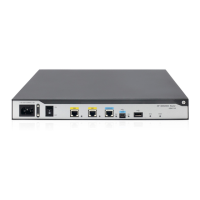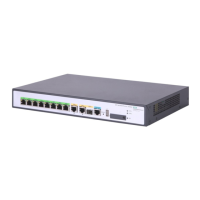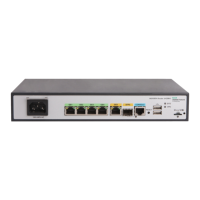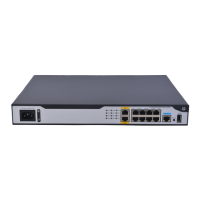24
Ste
Command
Remarks
6. (Optional.) Start the timer for
waiting for the expected
fragment.
ppp mp timer lost-fragment
seconds
By default, the timer is not started.
7. (Optional.) Disable MP
fragmentation.
ppp mp fragment disable
By default, MP fragmentation is
enabled.
After you configure this command
on an interface, the settings
configured with the ppp mp lfi
enable and ppp mp min-fragment
commands do not take effect on
the interface.
8. (Optional.) Set the interface
description.
description text
Optional.
The default setting is interface
name Interface, for example,
MP-group3 Interface.
9. Set the keepalive interval.
timer-hold seconds The default setting is 10 seconds.
10. Set the keepalive retry limit.
timer-hold retry retry The default setting is 5.
11. Set the MTU size of the
interface.
mtu size The default setting is 1500 bytes.
12. Set the expected bandwidth
of the interface.
bandwidth bandwidth-value
By default, the expected
bandwidth (in kbps) is the interface
baud rate divided by 1000.
13. (Optional.) Restore the default
settings for the interface.
default N/A
14. Bring up the interface.
undo shutdown By default, an interface is up.
15. Return to system view.
quit N/A
16. Enter interface view.
interface interface-type
interface-number
N/A
17. Assign the interface to a
specified MP-group interface,
and enable MP for the
interface.
ppp mp mp-group mp-number
By default, an interface is enabled
with PPP.
Configuring short sequence number header format negotiation
By default, an MP bundle receives and transmits fragments with long sequence numbers.
• To receive fragments with short sequence numbers, the local end should request the peer to transmit
short sequence numbers during LCP negotiation. After the negotiation succeeds, the peer transmits
fragments with short sequence numbers.
• To transmit fragments with short sequence numbers, the local end should ask the peer to send a
request for receiving short sequence numbers during LCP negotiation. After the negotiation
succeeds, the local end transmits fragments with short sequence numbers.
The sequence number format (long or short) of an MP bundle depends on the configuration of the first
channel joining the MP bundle.

